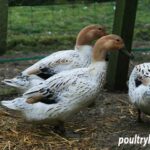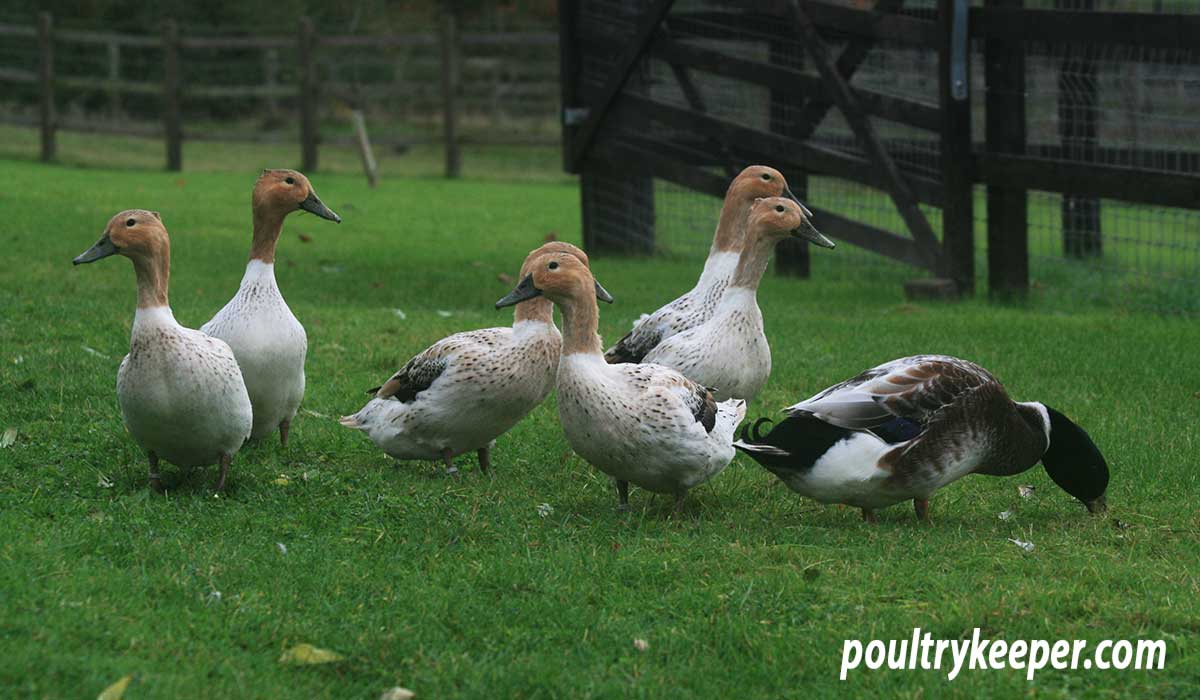
Breed In
Focus
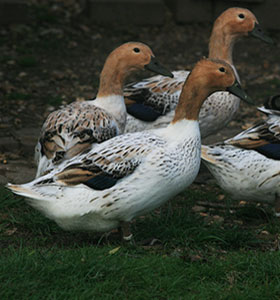
The spotlight is on Abacot Ranger ducks in this Breed In Focus, one of the light breeds developed with the Indian Runner.
What attracts me to the Abacot Ranger is the deep-fawn hoods of young ducks and the precise, detailed plumage markings on the upper breast, which look like they have been painted on with an artist’s brush. The drakes are just as attractive, carrying typical Mallard plumage during the breeding season, including a beautiful iridescent green lustre on their hoods.
Abacot Ranger ducks (also known as the Hooded Range in America, Streicherente in Germany and Eastern Europe and Le Canard Streicher in France) were created in Colchester in Essex UK, from 1917 to 1922 by Oscar Gray of the Abacot Duck Ranch. He used sports from Khaki Campbells and a White Indian Runner Drake to create the breed.
They were a popular utility duck supplying meat and eggs but became less popular in the UK and if it wasn’t for the work done in Germany by H. Lieker who stabilised the colour, they could have possibly been lost.
The British Waterfowl Association standardised these ducks in 1987. They are a light duck that rarely flies so can be kept in using a fairly low fence within the garden assuming the garden is safe from predators like foxes.
General characteristics
Classified as a light duck, Abacot Rangers are medium-sized ducks that are active and enjoy foraging. The waterfowl standard describes them as alert and busy, which I think couldn’t be more true.
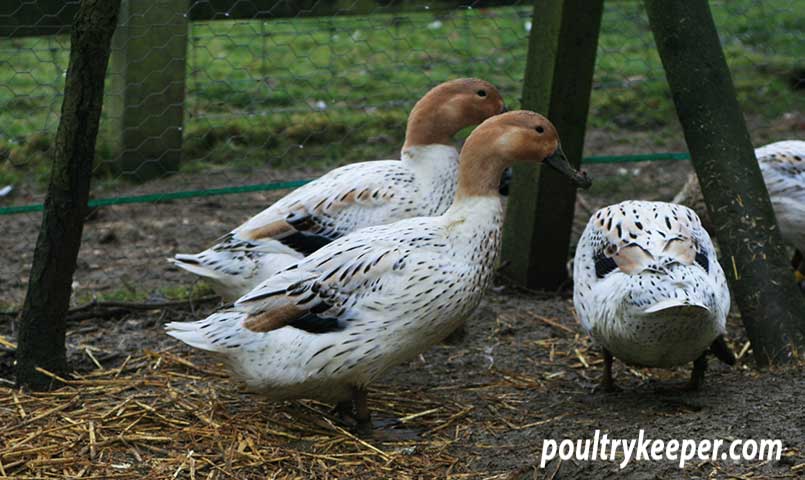
They have a fairly long body and will carry this at about 45 degrees from horizontal when moving around normally.
Abacot Ranger ducks cannot fly any great distance but will use their wings when running to fly in short hops if they want to get away quickly. They can easily be kept behind a low or portable fence or electrified poultry netting if poultry predators are a problem.
Abacot Ranger drakes
The Abacot Ranger drake can weigh between 2.3 to 2.5Kg, and he has a multitude of Mallard colours. His head is black with a green lustre when it catches the sunlight. This is separated from the rest of the body by a white ring encircling the neck. His bill is olive-green.
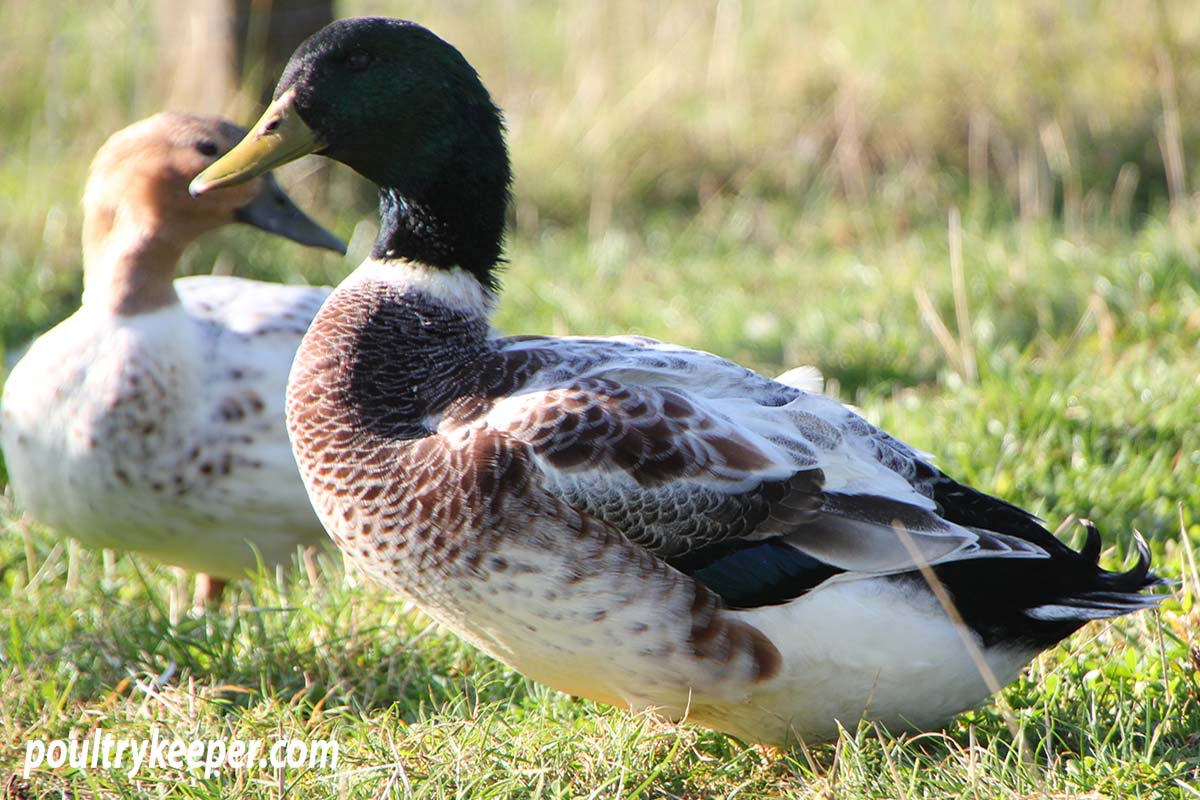
Black with green lustre
White ring encircles neck
Olive-green bill
Claret with white edging
Blues & greens with iridescence
White, stippled with black & tipped with white
Abacot Ranger male. Hover on a hotspot to view the description.
The breast of the Abacot Ranger drake is claret with white edging, which turns to a white/cream on his underside.
Wings are beautifully detailed. Primary feathers are white with some iridescent grey lustre. Secondary feathers vary with blues and greens and clear black and white bars. Upper coverts are white, stippled with black and tipped with white.
Legs and webs are orange.
Abacot Ranger ducks
The ducks are slightly lighter, ranging between 2 and 2.3Kg. They have a fawn-coloured head with dark graining, particularly on the top. This fawn hood is darkest in young adults; it fades as the ducks get older, and by 3 or 4 years old, the head can be almost white in some females. There is a clear line between the fawn hood and the white body colour.
The bill if the female is a slate colour, often with shades of green.
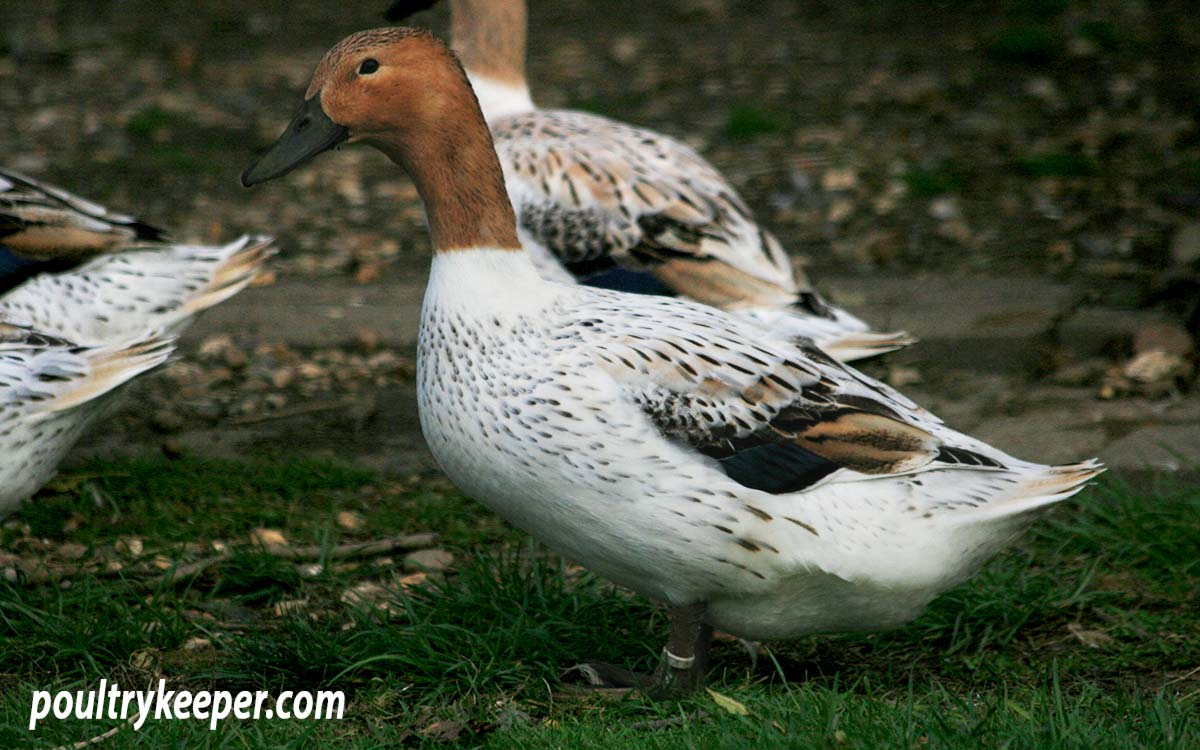
Fawn hood with dark graining
Clear line between hood and white body colour
Slate coloured bill with shades of green
Creamy-white ground colour body with streaks of brown.
Dark grey with a white edge
Dark grey legs and webs
Abacot Ranger female. Hover on a hotspot to view the description.
The body has a predominantly creamy-white ground colour with streaks of brown in various shades, which to me look like an artist has painted them. The wing’s primary feathers are the same as the drake. The upper coverts are dark grey with a white edge.
Legs and webs are both dark grey.
Eggs
Most Abacot Ranger ducks are reasonable egg layers. They lay a fairly large white egg (about an Indian Runner duck egg size) weighing between 60 and 70g. Good utility strains lay around 180 to 200 eggs per year.
During the 1922 egg-laying trials at Wye College, using 4 ducks, they achieved an average of 233.75 eggs per duck and came first!
For the table
Abacot Rangers look similar to Campbell ducks but are a bigger build, so they can also be useful for the table. The live weight of a duck is around 2.3 kg and the drake 2.5 kg.
Breeding hints
The usual ratio for light ducks of about five ducks to a drake should be applied. If you have too many drakes, they will compete too much for the females and over-mate, causing too much stress for the ducks.
Abacot Rangers rarely go broody and are not sitters, giving up before eggs hatch, so it is better to incubate eggs artificially. Since there are so few Abacot Rangers in Britain, many bloodlines are very close, so hatchability can be a problem.
Pay attention to the incubation humidity. Most duck eggs do not lose enough moisture during incubation, so the air sac is too small and the duckling too big to turn and hatch. Even incubating dry isn’t always sufficient if the humidity outside is high during a wet spring.
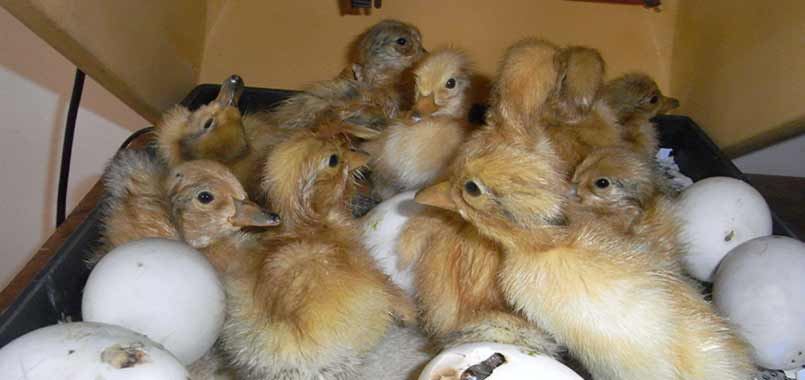
I aim for about 40% humidity on average, although it depends on the porosity of the eggshell. Shell porosity varies with the age of the ducks (thickness of the eggshell) and other factors, so I also monitor the air sac using a chart.
If a few eggs need higher humidity (the air sac is too large), then I move them into my hatcher with high humidity for a few days until the other eggs have the same size air space.
British bloodlines
Many of the original British bloodlines are thought to have been spoilt by outcrosses during the 1960s to Whalesbury hybrids, a popular hybrid created by Captain Leslie Bonnet. He shows a photo of the drake in his book Practical Duck Keeping which looks almost identical to an Abacot Ranger drake and would have been easily confused.
During my early years of breeding Abacot Rangers, I sourced stock from 2 or 3 breeders but was hatching birds with yellow-coloured bills and the wrong coloured webs from these birds, which I believe was likely to be a throw-back.
Thanks to the Germans who perfected the breed and maintained ‘clean’ Abacot Ranger (Streicher) bloodlines, we have been able to import birds back into Britain. It is a popular breed in Germany, and I counted no less than 90 exhibits at the Hannover poultry show in 2008.
There hasn’t been much interest in the Abacot Ranger by many of the bigger waterfowl breeders. Still, there are pockets of breeders in the UK reviving the breed using German bloodlines, and over the last few years, I have seen the number of Abacot Rangers at shows increasing.
Plumage
Abacot Ranger ducks have four different plumage types: down, juvenile, nuptial (sometimes called breeding plumage), and eclipse.
- From day-old, ducklings will have a fur-like down.
- After a few weeks, their first feathers will start to emerge, and by 8-9 weeks of age, they will have juvenile plumage. Both sexes look alike at this stage, and it’s hard to tell them apart.
- By 18-20 weeks of age, the young ducks moult into their adult nuptial or breeding plumage.
- After the breeding season, they will moult again into eclipse plumage, which is similar to juvenile plumage. They will stay in eclipse for about 16 weeks.
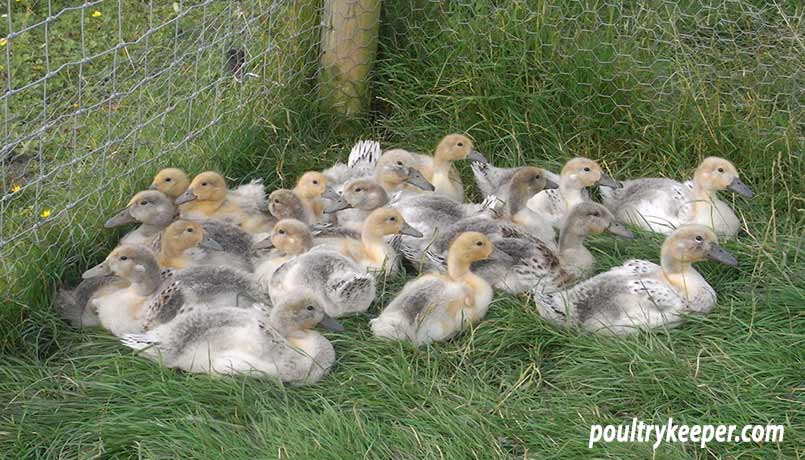
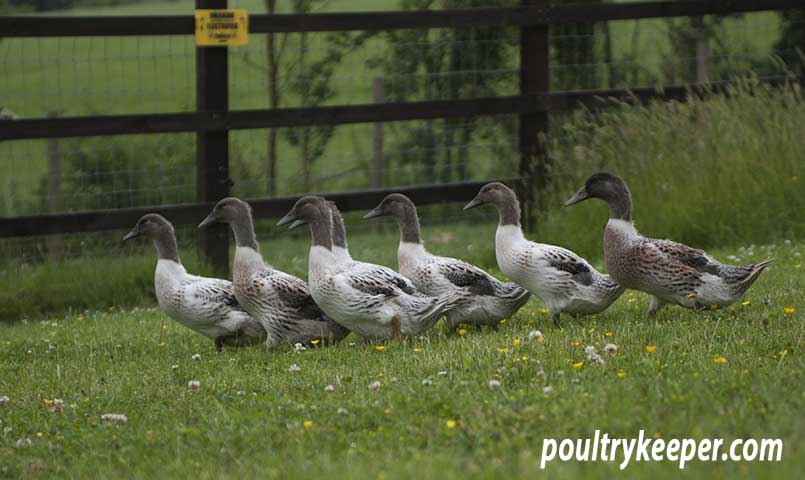
Every year after this, they will continue to change swap their nuptial and eclipse plumage. Here in the UK, they start to change into eclipse by the end of June and back to their nuptial plumage during late October, early November.
I call eclipse plumage their ‘camouflage plumage’. It is thought that wild Mallards do this to blend in with their environment while they are moulting/flightless and have young ducklings to care for that can’t fly.
Waterfowl standards and my photos show the birds in their adult, nuptial (breeding season) plumage.
The 'Silvers'
Abacot Ranges have Harlequin phase and dusky alleles, the same colour genotype as the Silver Bantam, Silver Runner and Silver Call duck.
Similarities with the Welsh Harlequin
It’s easy to confuse the Welsh Harlequin with the Abacot Ranger. They are similar in colour, except they have an additional brown gene.
This gene causes the male’s hood to appear bronze and gives the ducks a ground colour on their breast that’s a honey shade of fawn; there are no well-defined specks on the breast.
The hoods tend to be faded on the females too, although Abacot female ducks’ hoods will fade with age, some will fade almost to white.
Please be aware, some websites offering information on Abacot Ranger ducks have clearly copied information from several sources and contain a lot of errors.
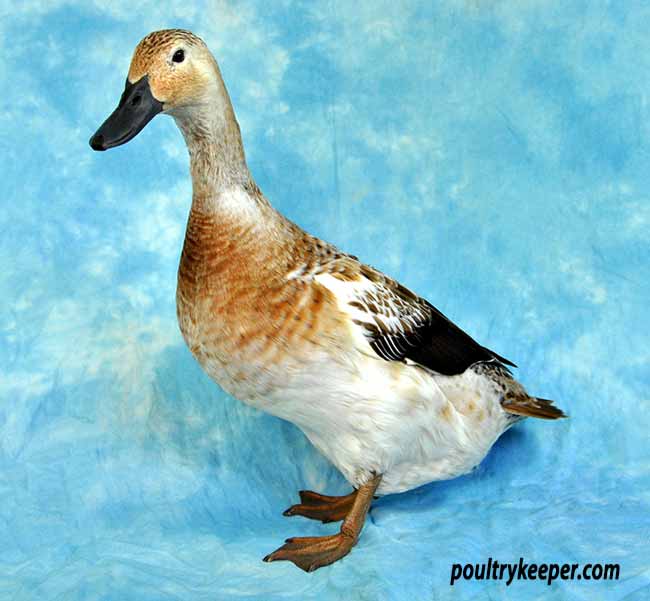
They show incorrect examples of Abacot Rangers and include Welsh Harlequin photos. It is a shame. There is already so much confusion with this breed!
Abacot Ranger ducks breed profile
Uses: Utility: meat, eggs
Egg colour: White.
Origin: Colchester, Essex, U.K.
Weight: Drake: 2.3-2.5 Kg, Duck: 2-2.3 Kg.
Classification: Light.
Useful to Know: Genetically silver ducks like the Abacot Ranger have two kinds of plumage: Nuptial (during the breeding season) and Eclipse (outside of the breeding season). Ducks look darker in Eclipse.
Photo gallery
If you have any photos of Abacot Ranger ducks you would be willing to share, please contact me.
Books
The following books are available. Links take you to the Amazon or other sellers’ pages.
- The Domestic Duck – C. & M. Ashton – P.77
- British Waterfowl Standards 2008 – P.69
- British Poultry Standards 2008 – P.383
Other Light Ducks
Bali Ducks
Uses: Exhibition, Utility: eggs. Eggs: 140 to 200 Blue to Green Eggs. Origin: Bali, East of Java. Weight: Drake: 2.3 Kg, Duck: 1.8 Kg. Classification: Light. Colours: Brown, Wild Mallard and White. Useful
Blue Swedish Ducks
Uses: Exhibition, Utility: meat.Eggs: 80 to 150 White Eggs.Origin: Pomerania (now Germany / Poland).Weight: Drake: 3.6 Kg, Duck: 3.2 Kg.Classification: Heavy.Colours: Blue (Standardised), Black also
Campbell Ducks
Uses: Utility: meat and eggs. Eggs: 250 to 300+ Eggs. Origin: Uley, Gloucestershire, U.K. Weight: Drake: 2.3 – 2.5 Kg, Duck: 2 -2.3 Kg. Classification:
Crested Ducks
Uses: Exhibition. Utility: meat and eggs.Eggs: 120 to 200 Eggs.Origin: Unknown but possibly Asia.Weight: Drake: 3.2 Kg, Duck: 2.7 Kg.Classification: Light.Colours: White, Coloured (markings must
Hook Bill Ducks
Uses: Exhibition, Utility: meat and eggs. Eggs: 100 to 200 Blue Eggs. Origin: Asia? Weight: Drake: 2 – 2.25 Kg, Duck: 1.6 – 2 Kg.
Magpie Ducks
Uses: Exhibition, Utility: meat. Eggs: 80 to 180 Eggs. Origin: Wales, U.K. Weight: Drake: 2.5 – 3.2 Kg, Duck: 2 – 2.7 Kg. Classification: Light.


